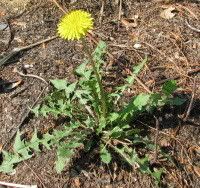 I figured the common dandelion would be a good starting point in this little chronicle of wild edibles, since even though I haven't done a ton with them in the past, it's one that almost everybody knows on sight, and there's nothing poisonous that looks like them.
I figured the common dandelion would be a good starting point in this little chronicle of wild edibles, since even though I haven't done a ton with them in the past, it's one that almost everybody knows on sight, and there's nothing poisonous that looks like them.The dandelion is a plant that Euell Gibbons was quite fond of. Dandelions are packed with vitamins, and were prescribed for vitamin defficiency-related illnesses before doctors really understood WHY the dandelion always seemed to remedy such maladies.
First-off, if you are going to try wild dandelion, make sure you're not harvesting them in an area where herbicides have been used. The leaves should be gathered in the spring when they are small, before flowers bloom. As the plant matures, you eat the crown (the sort of white base of the leaves, just above the root), the flowers, or the root. The roots can be harvested into the fall.
I just tried my first boiled dandelion root, and I'm rather surprised to say it was good, not even slightly bitter, though a bit woody in the center. The books I'd read recommended 2 water changes and baking soda and other stuff that would in my opinion make one feel that trying a wild edible is more trouble than its worth. I figured I'd try it under more reasonable cooking circumstances. I dug up the very plant you see above, washed it, snipped off a pinkie-sized piece of root, and scraped the outer skin off. I then threw it into about 4 cups of boiling water, with a little salt, and boiled it for about 10 minutes until it was soft. It was gone in 3 bites. It may be the center was woody because of the time of year, but next time I see a bunch of dandelions, I'll absolutely try this again with more of them.
I've seen dandelion greens for sale in some grocery stores now, and the thing about that is, the older, larger leaves of dandilion are the least palatable way to eat a dandelion. They do have that vitamin content, but they are just SO bitter, I can't imagine anybody really liking them. Why would you buy them, anyway, when dandelions are growing wild everywhere you look? Gather the youngest leaves before the plant flowers. Then you can simply toss them into a salad (that's very chique these days), steam them, or boil them like spinach. Salt and butter recommended. Dandelion greens will tend to taste more bitter than regular lettuce, but as you might expect, that's because they are infinitely better for you than regular lettuce.
Gibbons wrote about making dandelion fritters out of the flowers, and I haven't yet tried this, but will do so soon.
The roots can be cleaned, roasted in an oven, and ground up for a coffee substitute (you can do this with chickory too). You can also make dandelion wine from the flowers. I've attempted this, but unsuccessfully. If you're curious what it's like and don't want to go through picking buckets of flowers, you can find dandelion wine commercially.
As I start experimenting with dandelions again, I'll update this entry with more information!
References
Stalking the Wild Asparagus, Euell Gibbons
Field Guide to North American Edible Wild Plants, Thomas Elias & Peter Dykeman
No comments:
Post a Comment